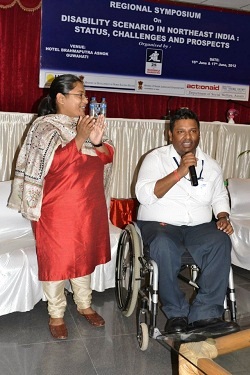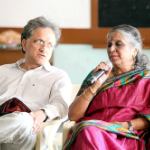One of the images of the British Raj that still remains in public imagination, more than sixty years after the English left our shores, is of a sahib holding court under a tree before a group of awed natives in some remote village of the country. The sahibs really knew how to get things done; at the time of independence, it is said that there were less than 5000 English officers in the administration of the undivided nation and one must admit that they didn’t do such a bad job after all compared with the performance of their present day inheritors— our brown sahibs in steel frame. One significant feature of the colonial administration --- and a key to its success-- was its emphasis on Safar or field tour as an important tool of administration. There were guidelines on Safar for all officers of the administration.
The Assam Land Records Manual, a slim but useful compendium of instructions on revenue administration framed in 1906 mentions that the Circle Officer of a Revenue Circle shall be on Safar from 1 st October to 15 th June every year. During this period, he shall be on tour of the mofussil areas for at least 125 days, including 25 overnight stays outside his headquarters.
But when I joined the Assam Civil Services in 1992 and was first posted as a Circle Officer, I found out that it was not possible to strictly follow the routine prescribed by the Assam Land Records Manual. The changed profile of a Circle Officer’s job over the years with multiple responsibilities outside his normal functions as a revenue officer pushed Safar down on his list of priorities. The increase in the number of Revenue Circles by bifurcation of the areas of the earlier Circles and improvement of the road and communication network brought the administration much closer to the people than before. Rarely does a Circle Officer today required to go on Safar with overnight stays outside his headquarters. In the present scenario, the grand field tours of the olden days are replaced by shorter visits that do not last more than one working day.
Nevertheless, from the early days of my career through all my years in the civil services, I have never missed an opportunity to occasionally escape from my office to the freedom of the great outdoors for the day. It was during such field visits that I have gained some of the most memorable experiences of my career as well as a deep insight into the life and problems of the people I served.
One such experience that still delights me took place on my visit to a remote Bodo village at Mushalpur, Nalbari District, more than two decades ago during my first posting. Mushalpur had a reputation of being a centre of extremist activities and officers were scared of being posted there. But the reality was far less frightening than the dark image of the place. Life in the country side went on in a quiet and unhurried pace like most villages of Assam. At that time, a state wide programme of intensive revision of electoral rolls was announced by the Election Commission of India. Like most of my colleagues in the civil services, I was also engaged on duty by the Election Department. That warm summer day, I was on a round of random checking of the house to house enumeration work done by the enumerators, usually local primary school teachers. When I entered this village, it was late afternoon; the sun was already in the west. The vast expanse of ripe paddy fields all around the village seemed ready to burst out in flames in the golden sunlight. The distant mountains of Bhutan on the north loomed bright and clear. It was a magnificent sight and a perfect time to be outdoors. I walked to the first house in the residential area of the village. There was nobody inside. I tried my luck on the next house. An old lady came out. I explained the purpose of my visit and requested her to produce the duplicate copy of the enumeration form that the enumerator had given them. The old lady looked at me dumbfounded; she didn’t know anything about the process. There was no one else in the house; all the other family members were out somewhere. I approached the third house in the neighbourhood, hoping for better luck this time. The main door of the mud plastered thatch house was kept ajar. Someone must be inside.
“Is there anyone inside”? I asked. No one answered me. I raised my voice and called again but still no one replied. My patience was running thin.
“Will someone please answer me”? I said loudly.
There was no reply. I was now getting exasperated and about to give up for the day and return home,
Suddenly, from somewhere amidst the paddy field behind the house, a female voice was heard, muffled by the distance.
“Wait. I am coming,”
I looked up and didn’t notice anyone at first.
Then I saw a girl running through the narrow track that crisscrossed the vast paddy field. The tall paddy stalks at times hid her from view but she became visible again, as she dashed through, her arms clearing the way and her long hair trailing along. The bright green and yellow dokhona that the girl wore matched with the colours of the paddy stalks in the sunlight. It was a stunningly beautiful scene.
The young girl ran all the way to the compound of her house where I stood, and stopped in front of me.
“What do you want”? She said, amidst gasps to regain her breath. She was sweating copiously. Her exertion had added a ruddy complexion on her face. The girl was probably in her late teens. I told her about the purpose of my visit. Unlike the old lady in the earlier house, the girl knew about the enumeration process. She rushed inside her house and in a moment brought the duplicate copy of the enumeration form that had been handed to them by the enumerator. I asked her about her family members and checked the entries made in the form. Her name too was in the list. When I read out her name, she blushed and smiled at me. The ruddy complexion on her face that was wearing off again reappeared. As I walked away from her house and looked at her for a last time, she was still smiling shyly. That moment, she appeared to me as having the most beautiful face in the world. More than twenty years later, I still cherish that brief encounter with the young Bodo girl in that remote village.
Not all field visits are however marked by such innocence. As Circle Officer at Bhuragaon, Morigaon District, an area dominated by immigrant Bengalis, I saw the divisiveness of people, sometimes close relatives, fighting for years over a small patch of land.
No other people of our region are as hardworking and resilient as the people who settled in the flood plains of the Brahmaputra valley mainly from Mymensingh District of former East Bengal.
They have a deep attachment towards their land and are fiercely protective of their interests over it. Disputes over land are common place in the villages of the immigrant community. As Circle Officer, on numerous occasions, I visited these villages to settle land disputes through a mixture of tact and conciliation and as a last resort, through a show of authority. In most cases I succeeded not because of any special attribute but because the parties themselves were tired of feuding for long and had been waiting for someone to bring them together and end their dispute. One such case of a long standing boundary dispute in a village under Bukani Mouza involved two brothers who were both past their prime. Most of their land had been eroded by the Brahmaputra and they had been left with just their homestead land. From land owners, both brothers were now reduced to working as wage labourers, yet their boundary dispute continued. One day during spring, I went to the village after receiving a petition by the elder brother to demarcate their land. Two lat mandals, a supervisory kanungo and two chainmen accompanied me to the village. We reached the spot early in the morning and began the demarcation process. The lat mandals unfolded the cadastral map of the village and placed it on a plane table. After identifying and measuring the dags on the map, the lat mandals set out to demarcate them on the field, marking the measurements with iron pegs. The process took considerable time and by the time it was completed, it was already noon. I summoned the brothers and in the presence of the sarkari gaonburrah and neighbours, showed them the demarcation. At first, the younger brother was not keen to accept his demarcated boundary but his sons insisted that he make peace with their uncle.
Finally, he relented and agreed to the demarcation, much to the relief of everyone present. The brothers embraced and decided to end their dispute.
Our job completed, we were about to return from the village when the elder brother approached me.
“What would people say if you go without having a cup of tea at my house?” he pleaded with folded hands.
I thanked him but politely refused his invitation for tea. Instead I requested him for a glass of water.
As an alternative, the old man suggested coconut water from one of the several coconut trees in his compound. We all agreed. At once the old man’s son climbed up a tree and brought down half a dozen coconuts.
The coconuts were neatly cut and placed before us but a small problem arose. How to drink the coconut water? There was just one broken glass in the man’s house and it was not possible to drink straight from the coconuts without spilling the liquid. As the silly problem confounded us, Deepor Deuri, one of the lat mandals had an idea. He collected our ball pens and placed them on a table. One by one he opened both ends of the ball pens and took out their refills. The empty ball pens now became our drinking straws. We laughed at the ingenuity of the lat mandal. Like a bunch of excited children trying something new, we happily sipped the coconut water through the hollow tubes of our ball pens. The old man too had a hearty laugh watching us.
After quenching our thirst with coconut water, we returned, leaving behind a contended old man.
******
Sometimes, quite unexpectedly, a routine field trip could turn into a nightmarish experience as I found out during my tenure at Naharkatiya, Dibrugarh district. Besides being posted as Circle Officer, I was also in charge of the Block for some time at Naharkatiya. As Block Development Officer, I frequently visited the villages for inspection of schemes.
One winter afternoon, along with a junior engineer, Kanak Barua, I was returning from the Sassoni area after verification of some wage generation schemes of the Block.
Nripen, a local youth engaged as my driver, was behind the wheel of my official jeep. That morning, instead of going to my office, we headed towards Sassoni for the inspection. We went from village to village driving over the embankment on the Burhi Dehing River inspecting all the schemes along the way. On our return, after making our way down the slope of the embankment, at one point, the jeep trembled and slowed down. Nripen furiously pumped the pedal and the jeep picked up speed again. Just as we reached a bend on the dusty track that led to the main road of Sassoni, a strong smell of petrol filled the vehicle. Suddenly, a loud noise was heard and what is one of the scariest moments of my life, the jeep’s engine caught fire with flames coming through the gaps in the dashboard. Kanak Barua, the junior engineer, who had been sitting in the middle between the Nripen and me, lunged out of the burning jeep. He landed on the edge of the road badly hurting his ankle. Both Nripen and I got out of the vehicle at the same time. In his haste, Nripen forgot to turn off the ignition of the jeep and the burning jeep kept moving on its own. I shouted at Nripen and he rushed to turn off the keys on the jeep. The vehicle stopped and Nripen managed to lift its bonnet. The flames shot up. Nripen dashed to a paddy seed bed besides the road and pulling out clumps of wet seedlings from the soil threw them over the flames. I too followed suit. Fortunately, the wet seedlings dripping with muddy water acted quickly to douse the fire. Both Nripen and I were drenched in muddy water, much to the amusement of people who gathered there from the nearby village. Nevertheless, we were relieved that the fire which had been caused by an overflow of fuel from the carburettor was extinguished without much damage to the vehicle.
Quite unexpectedly a field visit could also be a great learning experience as borne out from another incident during my tenure at Naharkatiya.
Once, I went on a cruise down the Burhi Dehing River on an engine boat with Sassa Kamal Handique, then MLA of Naharkatiya for an assessment of the erosion caused by the Burhi Dehing, one of the largest tributaries of the Brahmaputra, An executive engineer of the Flood Control Department also accompanied us. The weather was fine and the ride down the river was a pleasant experience.
Sassa Kamal Handique, eminent communist leader, knowledgeable and widely travelled, was a man of many parts. At one time, he had also been chairman of the powerful Public Accounts Committee of the Assam Legislative Assembly. A gentleman to the core, he commanded respect from all. It was a pleasure hearing him talk about his varied experiences in his rich baritone. Midday through the trip, the boat got struck in a sand bar in the middle of the river. The boatmen got down and using shovels started digging a canal in the sand around the boat. As the men worked, there was nothing for me to do but just to wait patiently. For the veteran communist there appeared no better opportunity than this mild afternoon in the middle of the river to impart some progressive thinking on his captive bourgeois audience of two. There, amidst the sounds of waves lapping against the boat and the toil of the boatmen, Sassa Kamal Handique held forth on the future of communism in the age of globalisation.
Only when the boat was extricated from the sand and we resumed the cruise, did his discourse end with the inevitable triumph of Communism. I was suitably impressed.
*******
No field trip undertaken by me has been as difficult and challenging as my trek to Panikanti during my posting as Block Development Officer at Sonapur near Guwahati. One day a group of youths met me at my office and made an unusual request.
“No government officer has ever been to our village. We want you to visit us and meet our people”
I was surprised to hear that such a village still existed and that too, so close to Guwahati. I made enquires from Bhubon Rahang, President of Nartap Gaon Panchayat under whose area the village was located.
Bhubon Rahang informed me that Panikanti is a village of about 100 families of a community known as Bhoi Khasi on a hill bordering Meghalaya and could be reached only by a trek through hilly terrain for 7-8 kilometres. He confirmed that no government officer had visited the village. The only presence of the government in the area is the local primary School.
I accepted the request of the youths and promised to visit their village soon.
I kept my promise. On 21st January, 2003, I set off for Panikanti accompanied by Rina Das, member, Zilla Parishad; Nabin Medhi, Panchayat secretary; Promod Saikia, junior engineer and Bhubon Rahang.
It was late winter; the numbing chill was no longer there. A mild sunny weather prevailed which made our trek quite comfortable. The trail to Panikanti wound through several hills with dense foliage all along. Bhubon Rahang mentioned the names of these hills as we passed. Deohar, Kandoni, Arong Kha, Tharwe Longklam, Karonthi, Rong Bawari. Sometimes, the trail got so narrow that only one person could pass through. My apprehension about getting exhausted midway through the trek proved unfounded. I was able to keep pace with the others all along though I had to stop a few times to catch my breath and rejuvenate myself. Finally after more than three hours of trekking, we reached the outskirts of the village in the afternoon. The sight that awaited us when we reached Panikanti overwhelmed us. The entire village was waiting to welcome us. Women and children lined up on both sides of the approach road; cheering and clapping as we walked into the village. We were ushered to the Panikanti L P School where a meeting presided by Uket Makri, the leader of the community, took place on what was certainly a historic occasion for the village.
I considered my trek to Panikanti as a glorious event of my career. Nothing that I had done gave me the kind of satisfaction that my visit to Panikanti did. It was for me a worthy accomplishment.
However, seven years later, on 12th October 2010, during my tenure as Sub Divisional Officer at Margherita, a trek to a village called Honjuwara accompanied by officers of the local Revenue and Forest Departments ended in an embarrassing failure for me. Honjuwara was similarly located as Panikanti and could be reached only after an arduous trek of 9-10 kilometres through difficult hilly terrain. Against the advice of some of my colleagues, I had decided to make the trip to Honjuwara.
Everything had appeared fine as we set off for Honjuwara under a clear autumn sky. But a few minutes into the trip, something happened to me. I could not keep pace with the others. I had to stop frequently to catch my breath. Partha Bairagi my junior colleague and Circle Officer, Margherita saw my condition and spoke to me firmly.
“You are not in a position to make the trip, Sir,”
It had been seven years since my memorable trip to Panikanti. I realised that time had taken its toll. I decided to withdraw from the trip to Honjuwara, much to the relief of my colleagues who went ahead without me. As I returned to Margherita, frustrated by my failure, I made a resolve to return and complete my trip to Honjuwara soon. However that was not to be as I was transferred from Margherita and the trip to Honjuwara, like so many other things in life, remained a wish, unfulfilled.







































